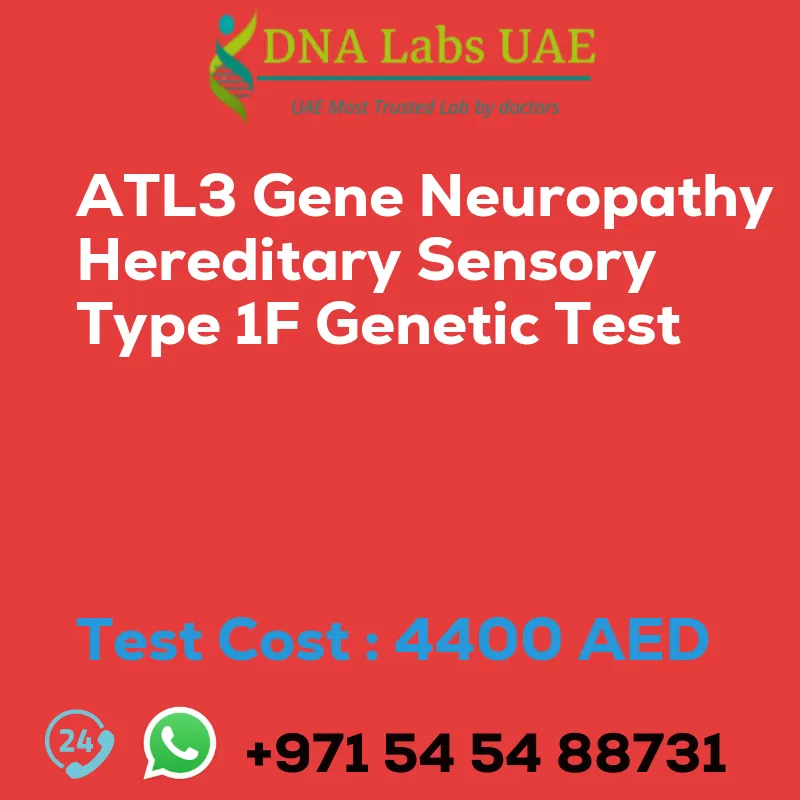ATL3 Gene Neuropathy hereditary sensory type 1F Genetic Test
Test Name: ATL3 Gene Neuropathy hereditary sensory type 1F Genetic Test
Components: Price 4400.0 AED
Sample Condition: Blood or Extracted DNA or One drop Blood on FTA Card
Report Delivery: 3 to 4 Weeks
Method: NGS Technology
Test type: Neurological Disorders
Doctor: Neurologist
Test Department: Genetics
Pre Test Information: Clinical History of Patient who is going for ATL3 Gene Neuropathy, hereditary sensory, type 1F NGS Genetic DNA Test. A Genetic Counselling session to draw a pedigree chart of family members affected with ATL3 Gene Neuropathy, hereditary sensory, type 1F.
Test Details: ATL3 gene neuropathy, hereditary sensory, type 1F is a rare genetic disorder that affects the nervous system. It is characterized by progressive loss of sensation in the limbs, particularly in the feet and lower legs. This condition is caused by mutations in the ATL3 gene, which provides instructions for making a protein involved in the maintenance and function of the mitochondria.
NGS (Next-Generation Sequencing) genetic testing is a type of genetic test that uses advanced sequencing technology to examine multiple genes simultaneously. It allows for the detection of mutations in the ATL3 gene, as well as other genes that may be associated with similar neuropathies.
NGS testing can provide a comprehensive analysis of a person’s genetic makeup and help in diagnosing hereditary sensory neuropathy type 1F. The test involves collecting a DNA sample, typically through a blood sample or saliva swab. The DNA is then sequenced using NGS technology to identify any mutations or variations in the ATL3 gene.
The results of the test can help confirm a diagnosis of hereditary sensory neuropathy type 1F and provide information about the specific genetic mutation involved. NGS genetic testing can be beneficial for individuals with symptoms suggestive of hereditary sensory neuropathy type 1F, as it can provide a definitive diagnosis and help guide treatment and management options.
It can also be useful for family members of affected individuals, as it can identify carriers of the gene mutation and provide information about the risk of passing on the condition to future generations.
| Test Name | ATL3 Gene Neuropathy hereditary sensory type 1F Genetic Test |
|---|---|
| Components | |
| Price | 4400.0 AED |
| Sample Condition | Blood or Extracted DNA or One drop Blood on FTA Card o |
| Report Delivery | 3 to 4 Weeks |
| Method | NGS Technology |
| Test type | Neurological Disorders |
| Doctor | Neurologist |
| Test Department: | Genetics |
| Pre Test Information | Clinical History of Patient who is going for ATL3 Gene Neuropathy, hereditary sensory, type 1F NGS Genetic DNA Test A Genetic Counselling session to draw a pedigree chart of family members affected with ATL3 Gene Neuropathy, hereditary sensory, type 1F |
| Test Details |
ATL3 gene neuropathy, hereditary sensory, type 1F is a rare genetic disorder that affects the nervous system. It is characterized by progressive loss of sensation in the limbs, particularly in the feet and lower legs. This condition is caused by mutations in the ATL3 gene, which provides instructions for making a protein involved in the maintenance and function of the mitochondria. NGS (Next-Generation Sequencing) genetic testing is a type of genetic test that uses advanced sequencing technology to examine multiple genes simultaneously. It allows for the detection of mutations in the ATL3 gene, as well as other genes that may be associated with similar neuropathies. NGS testing can provide a comprehensive analysis of a person’s genetic makeup and help in diagnosing hereditary sensory neuropathy type 1F. The test involves collecting a DNA sample, typically through a blood sample or saliva swab. The DNA is then sequenced using NGS technology to identify any mutations or variations in the ATL3 gene. The results of the test can help confirm a diagnosis of hereditary sensory neuropathy type 1F and provide information about the specific genetic mutation involved. NGS genetic testing can be beneficial for individuals with symptoms suggestive of hereditary sensory neuropathy type 1F, as it can provide a definitive diagnosis and help guide treatment and management options. It can also be useful for family members of affected individuals, as it can identify carriers of the gene mutation and provide information about the risk of passing on the condition to future generations. |








